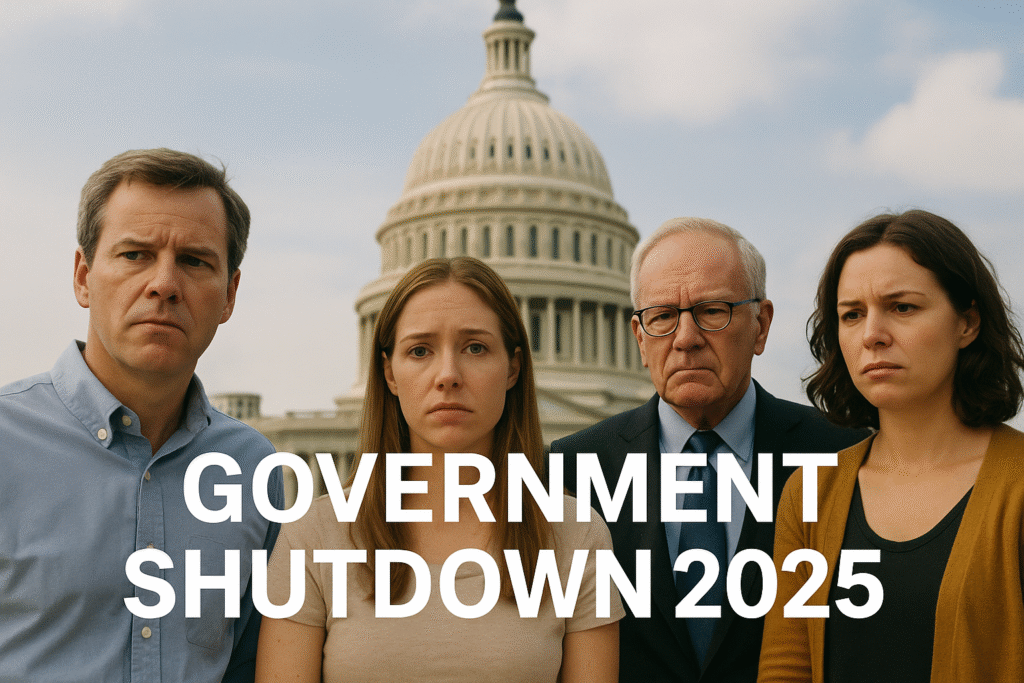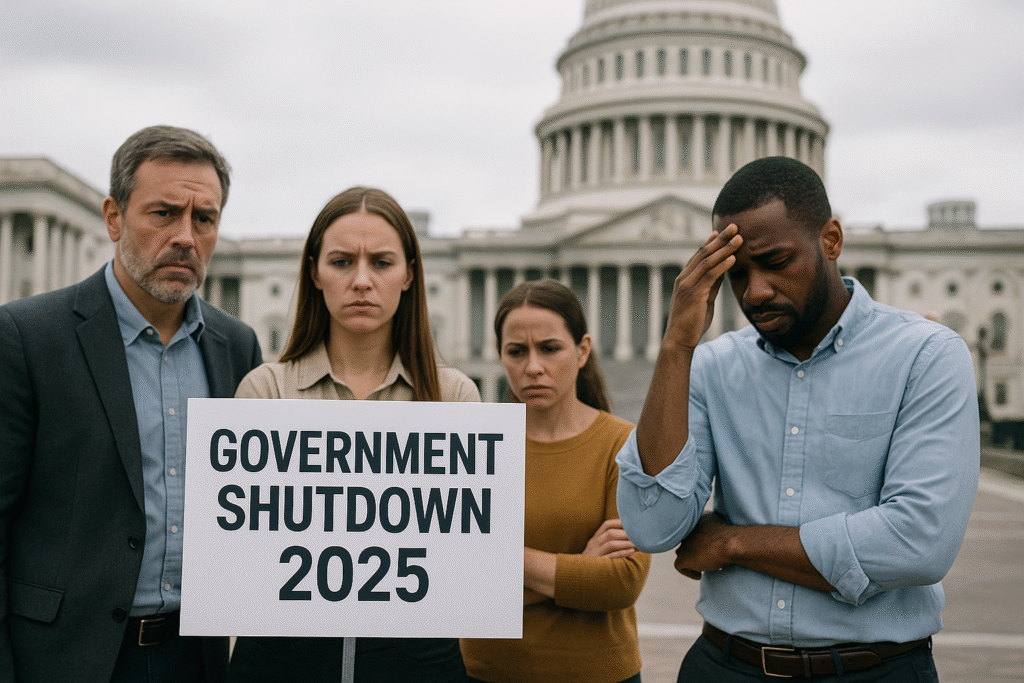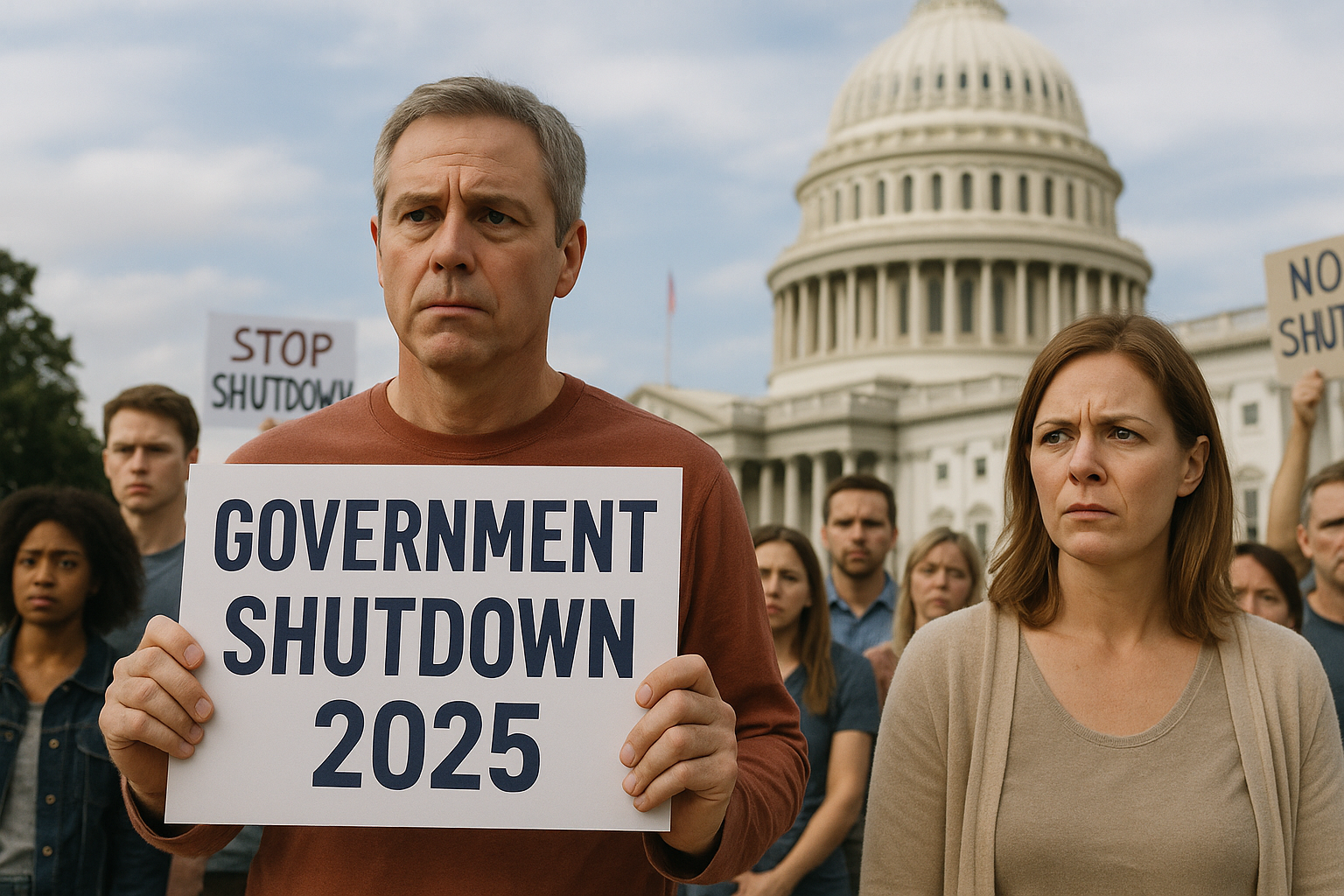Government Shutdown 2025: Congress faces an October 1, 2025 funding deadline and, as of late September, negotiators have not produced a full-year appropriations package or a broadly supported continuing resolution. A short-term stopgap has been proposed by House Republicans but it lacks Senate votes; the White House, Senate Democrats and the House majority remain at odds, making a partial or full federal shutdown possible if no deal is reached. Below I walk you through the timeline, the mechanics, which services would stop (and which won’t), what federal employees should expect, likely economic and practical fallout, and concrete steps families and businesses can take now.
1) What exactly is a government shutdown and why does it happen?
Government Shutdown 2025: A government shutdown occurs when Congress fails to pass appropriations bills (or a continuing resolution, CR) that fund federal agencies by the start of a fiscal year — October 1 in the U.S. Without a law authorizing spending, agencies must stop activities funded by annual appropriations unless those activities are legally “excepted” (like national security or public-safety missions). That’s not a philosophical choice; it’s a statutory requirement that forces agencies to furlough non-excepted employees and curtail nonessential services.
2) Where we are now — the political snapshot (late Sept. 2025)
- House Republicans passed a short-term funding bill to extend funding through November 21, but the measure needs Senate approval — and Senate Democrats have withheld unified support because they want reversals of recent healthcare cuts and other concessions before voting yes. That means, despite the House action, the Senate remains gridlocked and the October 1 deadline is looming.
- The White House called congressional leaders to the White House in a last-ditch effort to avert a shutdown; President Trump publicly urged a deal in statements while also pursuing aggressive budget priorities that have increased mistrust on the Hill.
These are the high-level facts that determine whether a stopgap deal clears both chambers in time to avoid a lapse in appropriations.

3) Quick timeline — key dates to watch
- September 30, 2025 (midnight): The fiscal year ends, and new appropriations must be in place for October 1 to be fully funded. If not, a partial or full shutdown begins.
- Late September–early October 2025: Negotiations and possible votes on continuing resolutions (short-term CRs) or targeted spending bills. Watch for Senate floor action and any presidential signature.
4) Which federal services stop — and which continue?
During a shutdown, agencies must identify which employees and activities are “excepted” (continue working) and which are “non-excepted” (furloughed). Typical patterns include:
Likely to keep operating (excepted):
- National security and public safety operations (active-duty military, border security, some law-enforcement functions).
- Air traffic control and TSA operations: commercial flights continue and air traffic controllers typically remain on the job.
- Emergency medical care at VA hospitals and Medicare/Medicaid payments continue for covered services.
- Social Security benefit payments generally continue (they are mandatory spending, not annual appropriations).
Likely to be curtailed or paused:
- National parks, museums and some federal services (visitor centers, national monuments) may close or reduce operations.
- Many grant programs, small-business loans and research awards could be delayed.
- Processing of new passports or immigrant visas may slow or pause depending on the agency’s internal guidance and staffing.
- Non-emergency federal administrative processes (some contract actions, non-essential training) often stop.
Bottom line: essential safety nets and mandatory programs usually keep flowing, but discretionary programs, permitting, courts and many public-facing services will experience slowdowns. Expect local variation — your state or agency may handle things differently.
5) What federal employees should know (furloughs, pay and OPM guidance)
The U.S. Office of Personnel Management (OPM) publishes the official plans agencies must follow. OPM issued updated guidance in late September 2025 telling agencies how to plan for furloughs, notify employees and manage benefits during a lapse in appropriations. Agencies will identify excepted employees who must continue to work without immediate pay and furloughed employees who will not work until funding is restored — although historically furloughed employees received retroactive pay after funding was reinstated.
Practical things to watch:
- Agencies should tell you whether you’re expected to work (excepted) or be furloughed; they should provide contact info and next steps.
- Retroactive pay historically follows after a shutdown ends, but benefits timing (payroll taxes, loan payments) may be affected in the short term. The OPM guidance outlines administrative steps for agencies and employees to follow.
If you are a federal employee, save cash where possible, confirm your status with your HR office, and sign up for official emergency notifications from your agency.

6) Who is most affected — communities, small businesses and federal contractors
- Small businesses that rely on federal contracts or permits (e.g., construction contractors, research labs dependent on grants) can see work delayed — which affects payrolls and contracts. Federal contractors may not be paid on time for new work if appropriations lapse.
- Communities near national parks and monuments often feel immediate economic pain from lost tourism revenue when those sites or visitor centers close.
- Citizens waiting for permits, grants or federal housing assistance may face delays. Expect variability across agencies — some may continue administrative functions while others stop.
7) The economics: what macro effects could a shutdown have?
Economists disagree on the long-term drag a short shutdown imposes, but even brief lapses reduce GDP in the near term, create uncertainty, depress consumer confidence and slow government-dependent sectors. A shutdown also raises borrowing and operational risks, and can magnify economic pain if it coincides with other shocks (e.g., a storm season or fragile markets). Analysts emphasize that the length matters: short, well-managed lapses create modest, temporary impacts, while prolonged shutdowns produce larger systemic effects.
One emerging risk for 2025: experts warn the current political standoff combined with executive proposals to implement deep administrative cuts could introduce backdoor effects on agency capacity even before an actual lapse — increasing market and operational uncertainty.
8) So who’s to blame — politics and the core disagreements
The immediate dispute is over a stopgap CR: House Republicans passed a short-term bill to extend funding to Nov. 21, but Senate Democrats want rollbacks of certain proposed healthcare cuts and more protections for domestic programs. The White House’s spending priorities and calls for broad cuts have contributed to mistrust across the aisle — making compromise politically harder right now. The upshot: both sides have leverage but neither has yet produced a mutually acceptable text, which increases the odds of a shutdown unless a last-minute deal happens.

9) Five practical steps for households & businesses (what to do now)
- If you’re a federal employee: Confirm your status with HR, create or update a short emergency cash buffer, and know how to access benefits information if payroll is delayed. OPM guidance has specifics on furlough procedures.
- If you rely on federal permits or contracts: Contact your contracting officer or program manager to learn contingency plans and whether deadlines will be tolled.
- If you travel or were planning government-driven events: Expect national-park closures and possible delays at some visitor centers; check local park websites and travel vendors.
- For students and researchers: Grant-funded projects may be paused. Contact program officers and university HR for guidance.
- For everyone: Keep an eye on reputable news wires (AP, Reuters) and official agency pages for verified, up-to-date instructions. Avoid rumor-driven social posts.
10) A short history lesson — how past shutdowns ended
Past shutdowns ended either through last-minute continuing resolutions or negotiated appropriations. The 1995–1996 shutdowns ended after bipartisan deals that reconciled policy disputes; the 2013 shutdown ended when the House passed a clean CR and the Senate agreed; the 2018–2019 shutdown (longest modern shutdown) concluded when Congress passed an appropriations package funded by emergency declarations and an eventual deal. Shutdowns typically resolve with compromise — but the political price (approval ratings, budget concessions, legal fights) can linger.
11) Where to follow accurate updates (trusted feeds)
If you want live, reliable updates, use these sources (linked and verified as of late September 2025):
- Associated Press — government shutdown coverage and live briefs.
- Reuters — day-to-day coverage on votes, bills and political dynamics.
- U.S. Office of Personnel Management (OPM) — official guidance for federal employees.
- USAFacts — plain-language explainer on what a shutdown means and local effects.
- Time / CBS News — analysis on economic and daily-life impacts.
FAQ — readers ask
Q: Is the government definitely going to shut down?
A: Not definite — but likely if Congress does not pass a CR or full appropriations before Sept. 30. With current gridlock and required Senate agreement for the House bill, risk is high absent last-minute compromise.
Q: Will Social Security stop?
A: No. Social Security and other mandatory benefit programs are funded by permanent law and typically continue during short shutdowns. However, some administrative services (local office appointments) may be delayed.
Q: Will mail stop?
A: The U.S. Postal Service is funded differently and typically continues operations even during federal shutdowns. But certain federal partner programs could be affected.
Q: Are furloughed employees paid?
A: Historically, employees furloughed during a shutdown received retroactive pay once funding was restored, but paychecks can be delayed in the short term. OPM outlines employee rights and agency responsibilities.
Quick checklist for reporters & bloggers (how to cover this responsibly)
- Use wire services and agency pages for counts and legal texts (AP, Reuters, OPM).
- Avoid amplifying unverified social posts about closures or layoffs. Confirm with agency press offices.
- When reporting impacts on local communities, verify with local agency contacts (National Park Service, local SBA offices, etc.) for on-the-ground status.
Final take — calm, prepare, and watch the calendar
A government shutdown is a politically painful but legally familiar process. The immediate risk for 2025 is real given the late-September political dynamics: the House-passed stopgap needs Senate votes and senators are leveraging the moment for policy concessions. For most Americans, core safety-net programs continue — but disruptions to parks, permits, grants and federal administrative processes are very likely if Congress does not reach a deal. The best approach is pragmatic: prepare (especially federal employees and contractors), follow official guidance, and watch the votes between now and October 1.
Sources & verified links
Below are the authoritative links relied on for facts and analysis in this article. Each was live and checked on September 29, 2025.
- Reuters — Republicans urge Democrats to agree to short-term bill to keep US government open. (Reuters)
https://www.reuters.com/world/us/republicans-urge-democrats-agree-short-term-bill-keep-us-government-open-2025-09-28/ - Associated Press — Government shutdown draws closer as congressional leaders head to the White House. (AP News)
https://apnews.com/article/trump-shutdown-government-chuck-schumer-8510b2fa4d40c4bbc058951c49c42468 - U.S. Office of Personnel Management (OPM) — Guidance for Shutdown Furloughs (Sep 28, 2025). (OPM)
https://www.opm.gov/policy-data-oversight/pay-leave/reference-materials/guidance-for-shutdown-furloughs-sep-28-2025/
Disclaimer
This article is informational and not legal, financial, or employment advice. It synthesizes reporting and government guidance available as of September 29, 2025. Because this is a live political situation, some details may change quickly; rely on the authoritative sources linked above (OPM, AP, Reuters, agency pages) for final instructions and updates. Images used in this article are royalty‑free or licensed for commercial use and are provided here for illustrative purposes.
